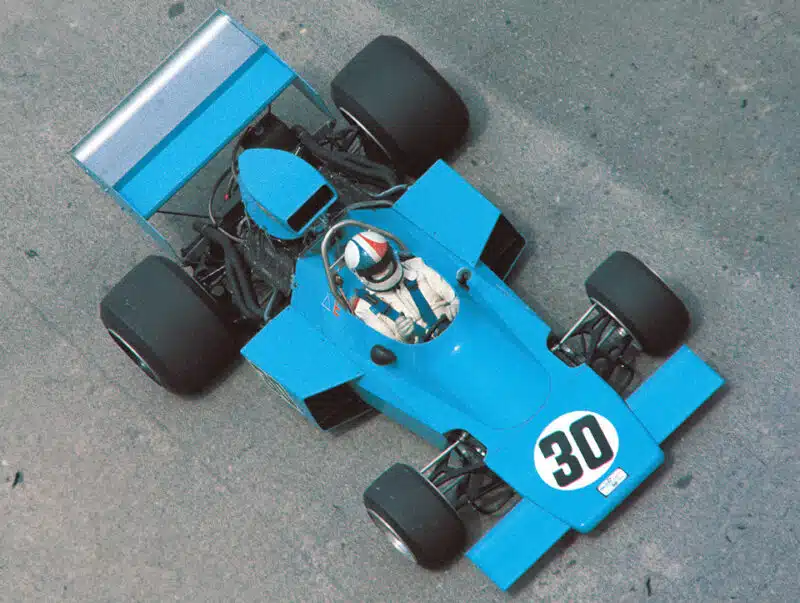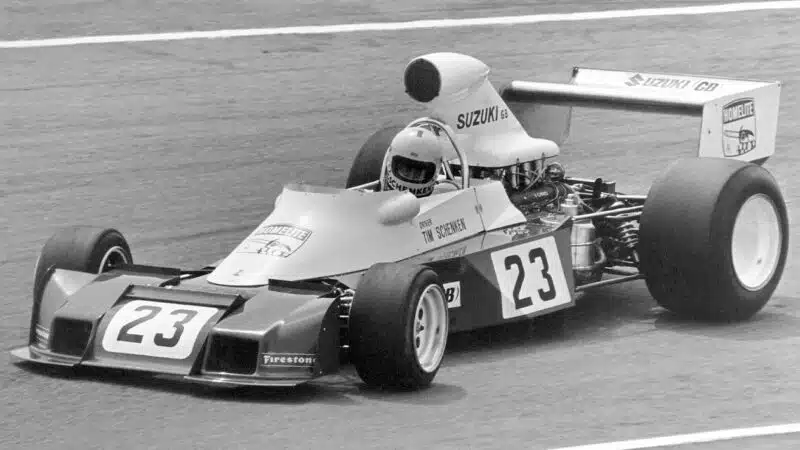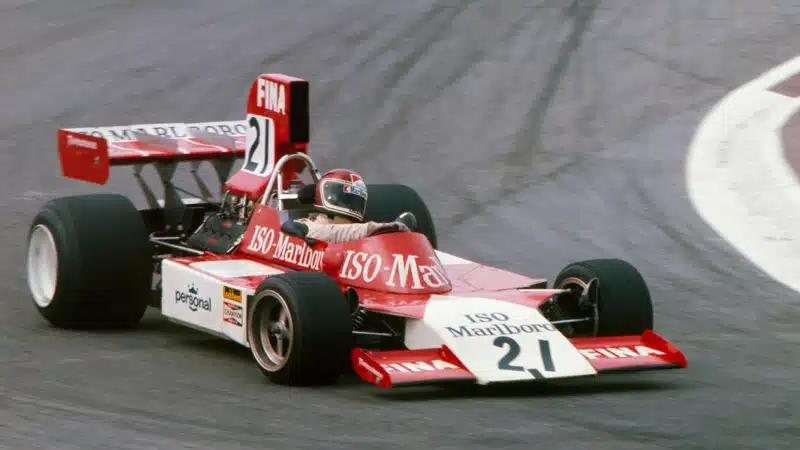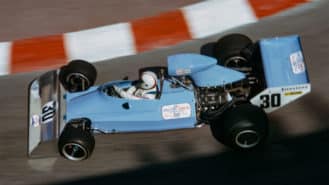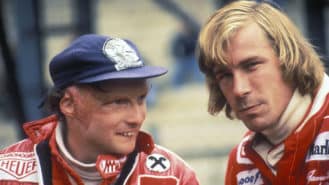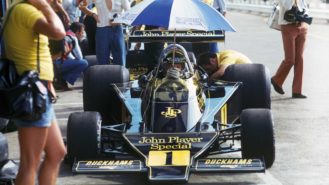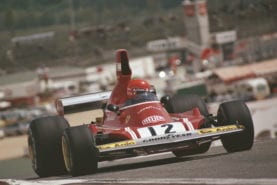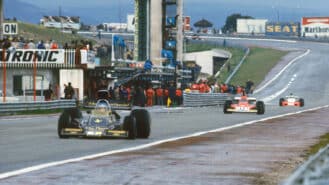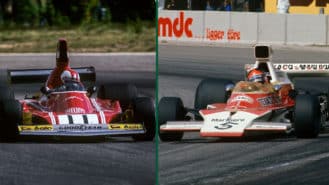Lauda put his Ferrari 312 B3 on pole for the 1974 Spanish Grand Prix with a lap of 1min 18.44sec – 0.03sec ahead of Ronnie Peterson in his Lotus 76, the team’s new car that soon proved to be less effective than the old Lotus 72 and was consequently abandoned by season’s end. But at Jarama it had not yet been jettisoned, and Lotus head honcho Colin Chapman was encouraged by Peterson’s having bagged a front-row grid slot with it and indeed by his team-mate Jacky Ickx’s P5, the result of a quali lap a respectable 0.81sec slower than that of Peterson – who, in terms of that elusive and perhaps god-given ability to wring a banzai lap out of an F1 car via a mixture of fearlessness and finesse, was the fastest driver in the world at that time.
On Sunday morning there was a lot of rain, and the asphalt was still sodden as the cars were driven off on their formation lap. Lauda made a clean start, but Peterson produced a sensational one, keeping his foot hard on the loud pedal and sawing at the wheel to control a lurid tank-slapper as he charged towards the first two right-handers, Nuvolari and Fangio. SuperSwede was always good in the wet, and he gradually pulled out a handy lead on the soaking track, while in second place Lauda did his best to hold his team-mate Clay Regazzoni at bay for the first dozen slippery laps.
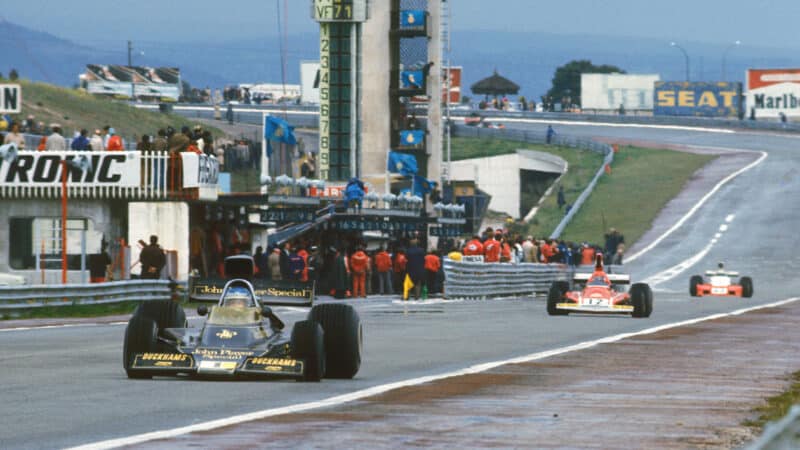
Peterson pulled out a lead on Lauda in the opening laps
Grand Prix Photo
Soon the rain stopped, and by lap 20 it was clear that slicks would be required. Tyre stops were not a routine exercise in F1 in those days – they occurred only for punctures or when the weather had changed so significantly that they became unavoidable. Peterson tyre-stopped on lap 20 – and the Lotus mechanics fumbled things a bit, sending him back out with new rubber after almost a minute of frenzied but chaotic activity. His engine would blow a couple of laps afterwards, so it was academic anyway. Lauda tyre-stopped on lap 21 – and the Ferrari guys changed all four wheels in about 35 seconds – which was pretty polished by the standards of 50 years ago.
A different kind of chaos now entered the equation, because no team was confident that its lap charts had been kept correctly during the hectic flurry of wheel changes between lap 20 and lap 25. One team’s lap charter thought Lauda was leading. Another insisted it was Regazzoni. The arguments raged, then everyone’s attention was distracted by a nasty accident that could have been extremely serious but, much more by luck than judgment, was not. On lap 37 Arturo Merzario, running fourth, felt and heard a snap as he barrelled through one of the faster corners at the back of the circuit, which breakage sent his Iso-Marlboro careening into the guardrail, launching it onwards and over it at head height, until finally it landed among a group of trackside photographers, inflicting glancing blows to four of them as it did so, and coming to rest with its front end on top of the pinned legs of a prostrate Giancarlo Piccinini, at that time one of the leading Italian F1 photographers. Astonishingly, no-one was badly hurt, and Piccinini was seen strolling around the paddock later that evening, accepting plaudits for bravery that he felt he did not in truth deserve.
The race ended at the two-hour mark, after 84 laps instead of the planned 90, by which point the organisers had issued an official lap chart. Luca di Montezemolo, the lissom 26-year-old Ferrari team boss, jumped the pitwall and repeatedly leapt into the air, his arms outstretched, as Lauda crossed the line to win. He did the same again when, half a minute later, Regazzoni finished second. The Ferraris had lapped Emerson Fittipaldi (McLaren; third), who had won the previous two Spanish Grands Prix, as well as Hans-Joachim Stuck (March; fourth), and they had twice lapped Jody Scheckter (Tyrrell; fifth), who scored F1 points for the first time.
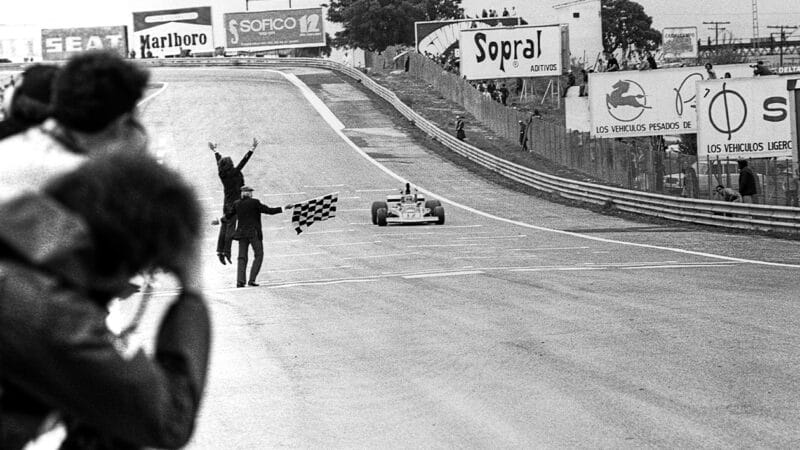
Luca di Montezemolo leaps into the air as Lauda crosses the line
Bernard Cahier/Getty Images
Regazzoni headed the F1 drivers’ world championship standings, with 16 points; second was Lauda, on 15, and third Fittipaldi, with 13. Lauda won one grand prix more that year (Zandvoort) as did Regazzoni (Nürburgring). Peterson won three of the remaining 11 grands prix, while Fittipaldi, Scheckter, and Reutemann all won two. By the time the F1 circus rolled into Watkins Glen for the 15th and final grand prix of the season, three drivers were still in contention for the F1 drivers’ world championship: Regazzoni (with 52 points), Fittipaldi (52 also), and Scheckter (45). Fittipaldi clinched it with a faultless drive to fourth place.
As I say, I hate to be that guy who says that F1 was better back then, but I would be very surprised if, by the time the F1 circus rolls into Yas Marina for the 24th and final grand prix of the 2024 season, there are even two drivers still in contention for the F1 drivers’ world championship, let alone three. Equally, I would be astonished if by that time seven drivers had won grands prix, as they did in 1974.
But perhaps I am biased. I was 11 in 1974, and that year I attended my first grand prix, at Brands Hatch, where I sat or more often jumped to my feet to watch Lauda lead for Ferrari until a puncture ruined his run six laps from the end, Scheckter then win for Tyrrell, and Reutemann drive from fourth on the grid to sixth at the flag, the elegance of his Gordon Murray-designed and Bernie Ecclestone-liveried Brabham BT44 making an impression on me so powerful that I still thrill to the sight of photographs of it half a century later.

Reutemann and Brabham BT44 at Brands Hatch
Grand Prix Photo

